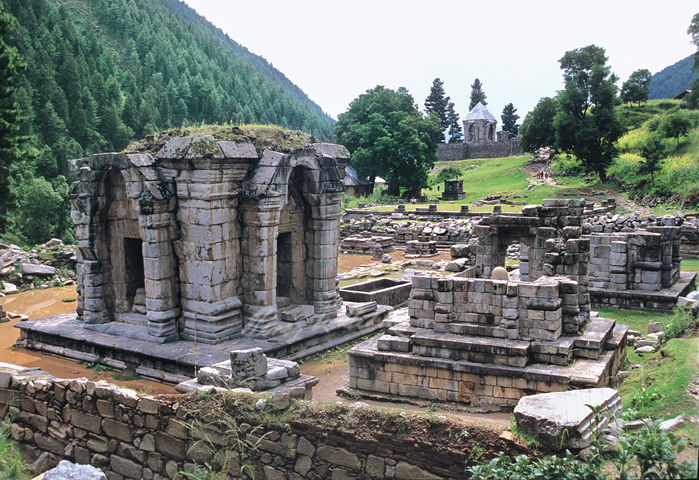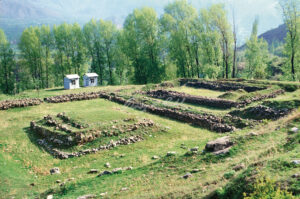Getting to know the ancient legacy of Kashmir

Narayan Nag Temple, Wangath. Pic: Benoy K Behl
Benoy K Behl
In the heart of the great Himalayas is a verdant valley, which has been described by poets and emperors as Paradise. Over the centuries, this beautiful vale has seen the blossoming of many of the most beautiful flowers of the philosophy of man.
Kashmir has always been a renowned centre of Hindu and Buddhist philosophy. In ancient times, it was known as ‘Sharada Peeth’, or ‘the seat of the deity of learning’.
It was here that the Indian philosophy of aesthetics was developed in great detail by the philosopher Abhinava Gupta in the 10th century. It is in Kashmir that Shaivism rose to its fullest heights. The manifestation of Shiva in the beauty of the world around us was worshipped as Shakti.
From the 1st to the 12th centuries, the Valley of Kashmir was one of the most important centres of Buddhist learning. Here Buddhist thought constantly interacted with Kashmir Shaivism. The Indian philosophy of aesthetics was also most highly developed in this beautiful valley. This philosophy believes that the moment in which we respond to something beautiful, is similar to Brahmananda , the bliss of salvation itself. We are transformed by our appreciation of beauty. It helps to lift the veils of the illusions of the material world, so that we can see the truth beyond.
In the 7th century, Hsuan Tsang, the Chinese pilgrim-traveler, visited Kashmir. He found that it was a flourishing centre of Buddhism which rivalled the importance of Eastern India. The Chinese pilgrim found many stupas and thousands of monks here.
By this time in the 7th century, Buddhism had entered its third major phase: the Vajrayana School, or the Vehicle of the Thunderbolt. The logic of this school was supposed to be as striking as a Thunderbolt and as indestructible as a diamond.
The complex rituals, chants and mudras or gestures of Vajrayana Buddhism were codified in the form of tantras. Tantra literally means to ‘carry on knowledge’.
The formidable mountains that ring the Valley did not prevent Kashmiri monks from traveling constantly to Tibet, Central Asia and China. Between the 4th and 10th centuries they took the teachings of Buddhism far and wide.
Kumarajiva was the son of Kumarayana from Kashmir. He is one of the greatest names in Chinese Buddhist history. Bronzes and manuscripts with paintings were also carried to distant lands by these teachers. This spread the aesthetics of Kashmiri art far and wide.
In 975 AD, King Yeshe Od of Guge in Tibet sent Rinchen Zangpo to Kashmir. This arduous journey was made to bring back scriptures with the original and pure knowledge of the faith. The mission was also to bring back artists to build, paint and sculpt new temples in Guge.

It is believed by the people of the trans-Himalayan lands that Rinchen Zangpo made 108 monasteries and temples. He had brought 32 artists to Guge from the Valley of Kashmir. They were to create the foundations of a lasting tradition of Buddhist art.
The painters and sculptors from Kashmir brought with them a highly sophisticated form of art. This was deeply rooted in the ancient Indian traditions.
Inside these temples, one enters an enchanted space. It is a world of graceful forms and colour. The purpose of this art is to take us into the deep and harmonious spaces of the inner self.
Amidst the natural beauty of the Kashmir valley, the most joyous Hindu and Buddhist philosophy was born. This saw beauty as a stepping stone towards the final truth and salvation itself. This philosophy led to the creation of art which fills us with joy and transforms us. There is a lyrical grace in the work of the Kashmiri artist. The legacy of ancient Kashmir is continued till today in the lands of Ladakh and Himachal Pradesh.
Under its series Glimpses Of Culture, India Habitat Centre is presenting a talk by Art Historian, Film-maker & Photographer (and the author of this article) Benoy K Behl on March 11, 6pm. A film Ancient Legacy
of Kashmir (produced by Behl for Doordarshan) will also be screened on the occasion.
The event is free. Click here to join the talk online


